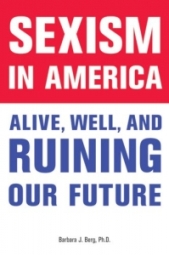
Sexism in America: Alive, Well, and Ruining Our Future
by Barbara J. Berg
—Reviewed by Saskia Vogel
 Does Sexism in America really show the truth about women’s lives in the new millennium? The reader sympathetic to the idea of gender equality hopes the answer is no.
Does Sexism in America really show the truth about women’s lives in the new millennium? The reader sympathetic to the idea of gender equality hopes the answer is no.
But it’s hard to brush off Barbara J. Berg’s clear language and arguments about how sexism is ruining the future of America. Even those reluctant to call themselves feminists may be spurred into action.
In 23 bite-sized chapters, Berg traces the women’s movement from the 1950s through the Reagan administration and 9/11 by examining social, economic and cultural issues that, she argues, indicate that sexism is indeed alive and well. Her idea of sexism is a robust one – she examines blatant discrimination against women. But she also makes the more common, less damning charge that the media depicts women in ways that aren’t exactly inspiring for young girls.
Berg begins her analysis with World War II, when the work of war required new thinking – and new government policy – about women. But the “There’s not a job a woman cannot do” ethos of the time melted away with the next decade’s return to domesticity, typified, Berg says, by television shows like Father Knows Best. The 1960s – well-trodden ground in histories of feminism, of course – may have reversed that, but the spirit of the time, Berg says, seems to have ebbed.
Berg, a historian and activist, wonders how women today managed to lose sight of the trials of last century, and those that linger today. Part of the problem, her research shows, is that people seem to have forgotten how women’s rights were secured in the first place. Roe v Wade seems essentially a catchword today, and the life-threatening measures women took before are distant memories.
As Berg reminds us that the personal is still political, she offers some concrete, and harrowing, findings about the status of women today. Catherine Hill of the American Association of American Women is quoted as saying, “One trend I’m noticing is the feminization of certain professions and specialties, resulting in lowering their status and salaries.” In addition to this subtle form of discrimination, Berg also observes that younger and more attractive women are favored over older women. As a result, older women don’t get into training programs, have less upward mobility, and get fewer raises. The resultant lower pension benefits keep women over 65, the majority of whom have social security as their sole income, particularly vulnerable to economic shifts.
Berg makes a strong case for the idea that pregnancy can spell redundancy in major corporations. Berg finds Bloomberg to be a particularly bad offender. One interviewee recounted that after announcing her pregancy, her commitment to her CEO position was questioned, and she suffered “demotions, decreases in compensation, and retaliation after I complained to human resources.”
Berg offers a fairly broad take on women in contemporary pop culture. Dora the Explorer and Hannah Montana notwithstanding, Berg argues that female empowerment is hard to find onscreen. Female solidarity is a punch line, or an impossibility, in Mean Girls and Gossip Girl. Chick lit and chick flicks overwhelmingly insist that careers preclude personal happiness for women. Hannah Montana may have the best of both worlds, but Berg leads us to believe that she is one of few.
There’s only some hope in the toy market which, Berg argues, shapes identity for girls. The Liv dolls, the newly-released, non-trampy, go-getting follow-up to the Bratz brand, may well be a sign that the times are changing. But Berg doesn’t mention them – likely because they’re fresh off the assembly line-and until they prove their mettle against the Bratz phenomenon, the jury is out. Another contender for the Bratz’ throne are the Disney princesses, though they’re no Liv. As Berg notes, marketing them all together as a brand may have been a stroke of ad man genius, but the princess archetype isn’t exactly great for girls either. Barbie’s plastic proportions may be superhuman, but at least she had goals and dreams – lots of them. Lawyer, doctor, astronaut, ballerina….
Excerpt: “[S]sexism has become camp. It’s riotous and cool. It’s chest-thumping fun, powerful, and self-reinforcing. The media exhibits all the heady recklessness of the old boys club, dumping over women to make men feel strong and in control.”
Further Reading: When Everything Changed: The Amazing Journey of American Women from 1960 to the Present and Full Frontal Feminism: A Young Woman’s Guide to Why Feminism Matters
*Photo courtesy magandafille.




Send A Letter To the Editors